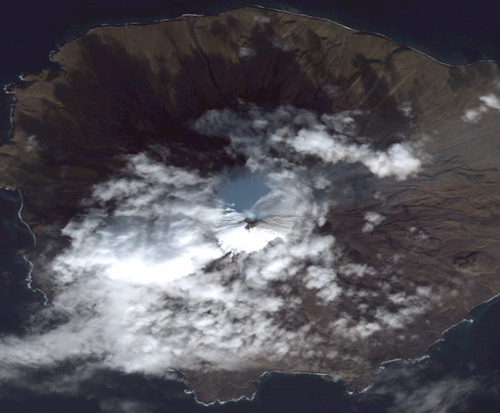Scientists monitoring, providing alerts on Pavlof and Cleveland volcanoes

(Phys.org) —Two of Alaska's most active volcanoes—Pavlof and Cleveland—are currently erupting. At the time of this post, their activity continues at low levels, but energetic explosions could occur without warning.
Located close to the western end of the Alaska Peninsula, Pavlof is one of the most active volcanoes in the Aleutian arc, having erupted more than 40 times since the late 1700's.
Pavlof has been erupting since May 13, 2013, with relatively low-energy lava fountaining and minor emissions of ash, steam, and gas. So far, volcanic ash from this eruption has reached as high as 22,000 feet above sea level. The ash plume has interfered with regional airlines and resulted in trace amounts of ash fall on nearby communities. The ash plume is currently too low to impact commercial airliners that fly between North America and Asia at altitudes generally above 30,000 feet.
Cleveland, located on Chuginadak Island in the Aleutian Islands, is also one of Alaska's most persistently active volcanoes. It has exhibited some sign of unrest almost annually since the early 1980's, with at least 19 confirmed eruptive events since then.
The current episode of eruptive activity at Cleveland has been characterized by single, discrete explosions, minor ash emissions, and small flows of lava and debris on the upper flanks of the volcano. On several occasions, ash-producing explosions have occurred reaching as high as 35,000 feet.
A small lava dome formed in the summit crater of Cleveland volcano in late January, 2013. At that time, the dome was about 300 feet in diameter and remained that size until a brief eruption on May 4 explosively removed a portion of the dome. The presence of a lava dome increases the possibility of an explosive eruption, but it does not necessarily indicate that one will occur.
Start with Science
The U.S. Geological Survey (USGS) is responsible for monitoring and issuing timely warnings of potential volcano activity. The USGS and its partners operate five volcano observatories, and monitoring of these two volcanoes is coordinated through the Alaska Volcano Observatory (AVO).
AVO is a joint program of the USGS, University of Alaska Fairbanks Geophysical Institute, and the State of Alaska Division of Geological and Geophysical Surveys.
Scientists at AVO were able to detect unrest at both Pavlof and Cleveland volcanoes that confirmed eruptive activity was occurring. AVO immediately sent notifications out to emergency-management authorities and those potentially affected.
When Will the Eruptions Stop?
Volcanic eruptions can last weeks to months, and sometime years, so the exact timing is unknown for when these two volcanoes will rest. AVO will continue to monitor them and provide updates in the event of future activity.
Detecting Signs of Unrest
Signs that the volcanoes were becoming restless were determined through a combination of monitoring data.
At Pavlof, a strong thermal signal was observed in satellite data at the summit that coincided with elevated seismic levels. Soon after these observations were made, more satellite data and pilot reports indicated that ash emissions were occurring.
At Cleveland volcano, explosions from the summit vent were detected by an infrasound array and seismic instruments on Umnak Island about 80 miles to the east, and later a thermal feature was observed at the summit in satellite imagery, which indicated hot material at or near the surface. The pressure sensors in the infrasound array pick up air waves generated by volcanic explosions. Because of the relatively slow speed of these waves, it took nearly 40 minutes to detect the explosion from that distance and issue an alert.
Ash Cloud Forecasts
AVO's analysis of the eruption, including the amount of ash and the duration of the explosive phases, are key inputs into the forecasts by National Oceanic and Atmospheric Administration's National Weather Service (NWS) of where the ash cloud will form and drift. These forecasts by NWS are used by the aviation industry to avoid flying into the ash.
The USGS developed a new ash cloud dispersal and fallout tool—a computer model known as Ash3d—that is being employed by AVO. The tool details where, when, and the amount of ash fall that is expected to occur. This information helps guide decisions on whether planes can safely land or depart, health warnings, potential impacts to infrastructure, and even when ash will stop falling and cleanup can begin.
Monitoring Tools
Pavlof is monitored with on-the-ground seismic stations (although only three of the seven instruments are currently operational), satellite remote sensing, and web cameras operated by the Federal Aviation Administration (FAA). A regional infrasound network operated by the University of Alaska Geophysical Institute has also helped detect explosions from Pavlof and Cleveland volcanoes.
Cleveland does not have a local seismic network and is monitored using only distant seismic and infrasound instruments and satellite data. Without local seismic instrumentation, scientists cannot forecast eruptions and smaller eruptions can be missed, especially because in the Aleutians, clouds commonly obscure the volcanoes in satellite data.
More information:
avo.alaska.edu/
www.avo.alaska.edu/map/index.p … lcs=on&othervolcs=on
Provided by United States Geological Survey

















